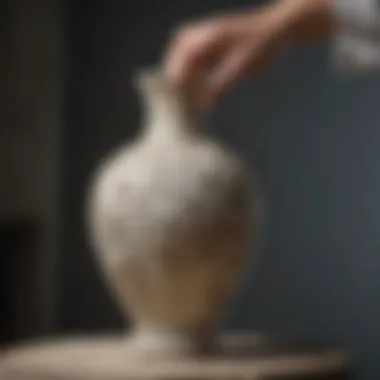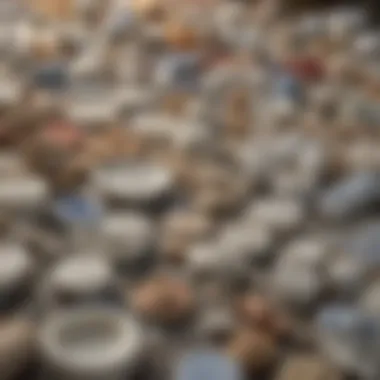Expert Tips for Choosing the Best Porcelain Glue: A Detailed Guide


Porcelain items hold a delicate charm, requiring meticulous care and attention when it comes to repairs or bonding. The choice of adhesive plays a pivotal role in the longevity and aesthetics of these items.
Types of Glue Options
When it comes to selecting the best glue for porcelain, various options are available in the market, each with its unique properties and applications. From epoxy adhesives to cyanoacrylate (commonly known as super glue) and silicone-based sealants, understanding the characteristics of each type is crucial.
Crucial Considerations
Before finalizing your choice of glue, several essential factors need to be considered. These include the strength of the bond required, the drying time of the adhesive, resistance to water and heat, as well as any specific requirements based on the type of porcelain being repaired.
Expert Recommendations
Expert artisans and craftsmen recommend conducting thorough research on different adhesive options before commencing any repair work on porcelain items. Due diligence in selecting the right kind of glue can make a significant difference in the quality of the repair and the overall appearance of the item.
Synthesizing Information
Introduction
Porcelain restoration and repair require meticulous attention to detail, especially when it comes to selecting the right glue. This comprehensive guide aims to navigate you through the intricate world of choosing the best adhesive for porcelain items. Your decision on the adhesive used can significantly impact the longevity and aesthetics of your beloved porcelain pieces. By exploring a range of glue options, considering essential factors, and benefiting from expert recommendations, you will be equipped to make well-informed decisions for your porcelain repairs.
Understanding the Importance of Choosing the Right Glue for Porcelain
Factors Affecting Glue Performance on Porcelain
Choosing the appropriate adhesive for porcelain hinges on several critical factors. The porosity and texture of the porcelain surface play a pivotal role in determining the effectiveness of the glue bond. Smooth surfaces might require different adhesives compared to textured ones due to variations in absorption rates. Understanding these nuances is essential for achieving optimal bonding results. Factors like temperature and environmental conditions also influence glue performance, with heat, cold, and humidity impacting the strength and durability of the bond.
Long-Term Implications of Incorrect Glue Selection
The repercussions of choosing the wrong adhesive for porcelain can be long-lasting. A mismatched glue may result in weakened bonds, discoloration, or even irreversible damage to your precious porcelain possessions. It is crucial to pay heed to the compatibility of the adhesive with the specific type of porcelain and the intended application. Investing time in selecting the correct glue upfront can save you from potential headaches and costly repairs in the future.
Overview of Common Glues Used for Porcelain
Epoxy Resin
Epoxy resin is a popular choice for bonding porcelain due to its exceptional bonding strength and versatility. Its ability to form durable, gap-free bonds makes it suitable for a wide range of porcelain repair applications. However, prolonged curing times and the need for precise mixing ratios are important factors to consider when using epoxy resin for porcelain repairs.


Cyanoacrylate (Super Glue)
Cyanoacrylate, commonly known as super glue, is renowned for its quick bonding properties. It is ideal for smaller, non-load-bearing repairs on porcelain items. While super glue provides rapid results, its brittleness and limited gap-filling capabilities make it less suitable for certain porcelain bonding projects that require flexibility and resilience.
Silicone Adhesive
Silicone adhesive offers excellent flexibility and resistance to moisture, making it a preferred choice for repairing porcelain items exposed to varying environmental conditions. Its waterproof properties and ability to absorb stress make it a reliable option for bonding porcelain tiles, figurines, or dinnerware. However, silicone adhesive may not provide the same level of bond strength as epoxy resin or polyurethane adhesives in certain applications.
Polyurethane Adhesive
Polyurethane adhesive strikes a balance between strength and flexibility, making it a versatile option for bonding porcelain items. Its high impact resistance and compatibility with various surfaces enhance its usability for different repair scenarios. However, longer curing times and precautions against excess foaming during application are considerations to keep in mind when using polyurethane adhesive for porcelain repairs.
Impart a well-thought-out narrative with meticulous attention to detail: this guide aims to equip you with the knowledge and insights necessary for mastering porcelain repairs with confidence and precision.
Factors Influencing Glue Performance
In this detailed segment on factors influencing glue performance, the critical role of selecting the right adhesive for porcelain items is underscored. Successful porcelain repairs hinge on understanding and optimizing key elements that affect adhesive efficacy. Factors like surface texture and porosity impact how well a glue adheres and the durability of the bond. By delving into these nuances, readers will grasp the significance of meticulous glue selection in porcelain restoration projects. Careful consideration of these factors ensures an informed approach to achieving successful outcomes.
Porcelain Surface Texture and Porosity
Impact of Smooth vs. Textured Surfaces
Exploring the impact of smooth versus textured surfaces is crucial in comprehending how different porcelain textures influence adhesive bonding. Smooth surfaces offer a seamless bonding experience, resulting in a uniform and sturdy bond. On the other hand, textured surfaces provide enhanced grip for certain types of glues, facilitating stronger adhesion in specific repair scenarios. Understanding the interplay between surface textures equips readers with the knowledge needed to choose the most suitable adhesive for their porcelain restoration needs.
Absorption Rate of Porcelain
The absorption rate of porcelain plays a pivotal role in determining the effectiveness of glue bonding. Porous porcelain materials have higher absorption rates, requiring adhesives with quick curing times to prevent seepage and ensure a strong bond. On the contrary, low absorption porcelain items necessitate different adhesive characteristics for optimal bonding. By delving into the nuances of porcelain absorption rates, readers can tailor their adhesive selection based on the specific properties of the items being repaired. A thorough grasp of absorption dynamics enhances the precision and longevity of porcelain repairs.
Temperature and Environmental Conditions
Effect of Heat or Cold on Glue Bonding
Understanding how temperature variations affect glue bonding is essential for successful porcelain repair projects. Extreme heat can compromise adhesive integrity, leading to weak bonding and potential failure of the repair. Conversely, cold temperatures can slow down the curing process of certain adhesives, affecting the bond's strength. By considering temperature fluctuations during the repair process, readers can proactively address these challenges and ensure optimal bonding outcomes. Adapting adhesive choices to environmental conditions is key to achieving durable and reliable porcelain repairs.
Humidity's Role in Adhesion


Humidity levels play a critical role in adhesive performance when bonding porcelain items. High humidity can expedite the curing process of some glues, accelerating bond formation. However, excessive moisture in the air may affect the adhesive's composition and bonding capabilities, necessitating adjustments in application techniques. By taking into account humidity levels, readers can optimize adhesive performance and enhance the quality of their porcelain repairs. An informed approach to managing humidity's impact on adhesion elevates the success rate of intricate porcelain restoration projects.
Choosing the Right Glue for Specific Porcelain Items
When it comes to dealing with delicate porcelain items, choosing the right glue is of paramount importance. The adhesive selection can make a significant difference in the longevity and aesthetics of the repaired piece. Whether repairing cracks in porcelain figurines, bonding porcelain tiles, or fixing broken porcelain dinnerware, the type of glue used plays a crucial role. To ensure a successful repair or bonding process, understanding the specific requirements of each porcelain item is essential. Factors such as the area of application, durability needed, and safety considerations must be meticulously evaluated.
Repairing Cracks in Porcelain Figurines
Optimal Adhesive for Delicate Areas
Repairing cracks in porcelain figurines often requires an adhesive that can delicately bond the fragile surfaces without causing any damage. Optimal Adhesive for Delicate Areas is designed to provide strong adhesion while being gentle on the intricate details of the figurines. Its key characteristic lies in its ability to create a secure bond without impacting the aesthetic appeal of the piece. This adhesive is a popular choice for repairing porcelain figurines due to its precision application and ability to seamlessly blend into the original design. While it offers excellent bonding strength, it is essential to note that prolonged exposure to moisture may diminish its effectiveness.
Blending Glue for Seamless Repairs
Blending Glue for Seamless Repairs is crucial for achieving flawless results when restoring porcelain figurines. This type of glue allows for meticulous blending along the repaired area, ensuring that the cracks are virtually invisible once the repair is complete. Its unique feature lies in its seamless integration with the porcelain surface, creating a smooth and uniform finish. While this adhesive excels in providing invisible repairs, it may require precise application techniques to avoid excess glue bulging. However, with careful use, Blending Glue for Seamless Repairs can elevate the quality of porcelain figurine restoration projects.
Bonding Porcelain Tiles
Adhesive Strength Requirements
When bonding porcelain tiles, the adhesive's strength is a critical factor to consider. Adhesive Strength Requirements are tailored to meet the demanding needs of porcelain tile applications. Its key characteristic is the high bonding strength it offers, ensuring a durable and reliable bond between the tiles. This type of adhesive is a popular choice for its robust performance and ability to withstand heavy foot traffic and environmental stressors. While Adhesive Strength Requirements excel in providing a strong bond, careful surface preparation is necessary to achieve optimal adhesion.
Resistance to Moisture and Temperature Changes
Porcelain tiles are often exposed to moisture and temperature changes, making resistance to these elements essential in the adhesive selection. Resistance to Moisture and Temperature Changes is designed to withstand frequent exposure to humidity and fluctuations in temperature without compromising the bond. The key characteristic of this adhesive is its ability to maintain its integrity even under challenging environmental conditions. It is a beneficial choice for bonding porcelain tiles in areas prone to moisture, such as bathrooms and kitchens. While offering exceptional resistance, users should ensure proper application to maximize its performance.
Fixing Broken Porcelain Dinnerware
Food-Safe Glue Considerations
Repairing broken porcelain dinnerware requires an adhesive that is safe for contact with food. Food-Safe Glue Considerations prioritize the use of adhesives that are non-toxic and food-grade certified. The key characteristic of this type of glue is its adherence to safety standards, ensuring that the mended dinnerware remains safe for use with food. This adhesive is a popular choice for repairing porcelain dinnerware as it maintains the items' integrity while being safe for food contact. While providing a secure bond, users should follow manufacturer guidelines to ensure food safety standards are met.
Dishwasher and Microwave Compatibility
Dishwasher and Microwave Compatibility are crucial considerations when selecting glue for fixing porcelain dinnerware. The adhesive used must be able to withstand the high heat and moisture exposure typical in dishwashers and microwaves. Its key characteristic is its ability to remain stable and intact after exposure to dishwasher cycles and microwave heating. This feature ensures that the repaired dinnerware can be safely used for everyday dining purposes. While offering convenience and practicality, users should verify the compatibility of the adhesive with specific dishwasher and microwave models to prevent any potential damage.


Application Techniques and Best Practices
When delving into the intricate world of selecting the most suitable glue for porcelain items, understanding application techniques and best practices becomes a critical aspect. Proper application techniques not only ensure a strong bond but also contribute to the longevity and aesthetics of the repair. This section will focus on specific elements like surface preparation, precise application methods, and gap-free bonding, offering valuable insights for achieving top-notch porcelain repairs.
Surface Preparation for Optimal Bonding
Cleaning and Degreasing Porcelain Surfaces:
Cleaning and degreasing porcelain surfaces play a pivotal role in achieving optimal bonding results. By removing any dirt, oils, or contaminants from the surface, the adhesive can form a secure connection with the porcelain, enhancing its adhesion capabilities. The key characteristic of this process lies in its ability to create a clean and receptive surface for the glue application, ensuring maximum bonding efficacy. The unique feature of cleaning and degreasing porcelain surfaces is its compatibility with various types of adhesives, making it a versatile and widely preferred choice for porcelain repairs.
Promoting Adhesion Through Sanding or Scoring:
Promoting adhesion through sanding or scoring is another essential step in surface preparation for porcelain bonding. By roughening the smooth surface of porcelain, either through sanding or scoring, the adhesion surface area increases, promoting a stronger bond with the adhesive. The key characteristic of this technique is its ability to enhance the bonding strength by providing a textured surface for the glue to grip onto, thereby improving the overall bonding performance. The unique feature of promoting adhesion through sanding or scoring lies in its effectiveness in enhancing the bonding capabilities of various adhesive types, resulting in durable and reliable porcelain repairs.
Ensuring Precise and Gap-Free Application
Utilizing Applicators or Precision Tools:
Ensuring a precise and gap-free application is crucial in achieving seamless porcelain repairs. Utilizing applicators or precision tools not only helps control the amount of adhesive applied but also allows for targeted application in delicate areas. The key characteristic of using these tools is the ability to achieve accuracy and consistency in glue distribution, ensuring a secure and uniform bond across the repaired surface. The unique feature of utilizing applicators or precision tools is their versatility in accommodating different viscosity adhesives, providing customized application solutions for various porcelain items.
Techniques for Minimizing Excess Glue:
Techniques for minimizing excess glue are essential in creating a clean and professional finish to porcelain repairs. By employing methods to control and remove excess adhesive during application, such as wiping, scraping, or using precision tools, the risk of visible glue residues or uneven bonding is minimized. The key characteristic of these techniques is their ability to enhance the aesthetics of the repair by ensuring a neat and tidy finish, free from excess glue spillage. The unique feature of minimizing excess glue lies in its contribution to achieving a refined and polished look to the restored porcelain items, elevating the overall visual appeal and quality of the repair.
Conclusion
In a comprehensive guide to choosing the best glue for porcelain, the conclusion serves as the pivotal endpoint that encapsulates the wisdom gleaned throughout the various sections. It is the amalgamation of intricate details, expert recommendations, and practical considerations that equip one with the knowledge needed to handle porcelain repairs effectively and efficiently. The conclusion acts as a cornerstone, emphasizing the critical role of adhesive selection in ensuring the longevity and aesthetics of porcelain items. By reflecting on the key points discussed and underscoring their relevance, readers can leave empowered with the expertise necessary to undertake porcelain restoration projects with confidence and precision.
Final Thoughts on Mastering Porcelain Repairs
Importance of Practice and Patience
Delving into the realm of mastering porcelain repairs, the importance of practice and patience emerges as a fundamental pillar supporting the edifice of successful restoration endeavors. This intrinsic aspect underscores the significance of honing one's skills through repetition and diligence, allowing for a gradual mastery of the delicate art of porcelain repairs. The patience required to navigate through intricate bonding processes and the practice essential for refining techniques are central to achieving pristine results in porcelain restoration. Embracing the virtues of practice and patience not only cultivates expertise but also instills a sense of craftsmanship and finesse in handling porcelain items.
Embodying resilience and dedication, the practice of patience enables individuals to navigate the intricate nuances of porcelain repairs with grace and precision. By engaging in repeated practice sessions, craftsmen can refine their adhesive application techniques, troubleshoot common challenges, and elevate the quality of their repairs. The discipline required to exercise patience during meticulous restoration tasks cultivates a meticulous attention to detail and a profound understanding of the materials involved.
Embracing the Art of Porcelain Restoration
Within the realm of porcelain restoration, embracing the art of this intricate craft stands as a transformative journey towards preserving and enhancing the beauty of porcelain items. Embracing the art of porcelain restoration involves not only repairing damages but also breathing new life into cherished pieces through meticulous care and attention. This aspect celebrates the fusion of technical expertise and artistic flair, where each repair serves as a testament to the reverence for tradition and craftsmanship.
Central to the art of porcelain restoration is a deep appreciation for the cultural and historical significance of these objects, guiding repair enthusiasts to approach each project with reverence and sensitivity. Embracing the art of restoration entails not merely fixing broken pieces but reviving them with a touch of creativity and expertise, infusing them with renewed splendor and functionality. This approach transcends mere repair work, evolving into a meditative practice that enriches both the object and the artisan, fostering a profound connection with the artistry and craftsmanship of bygone eras.







